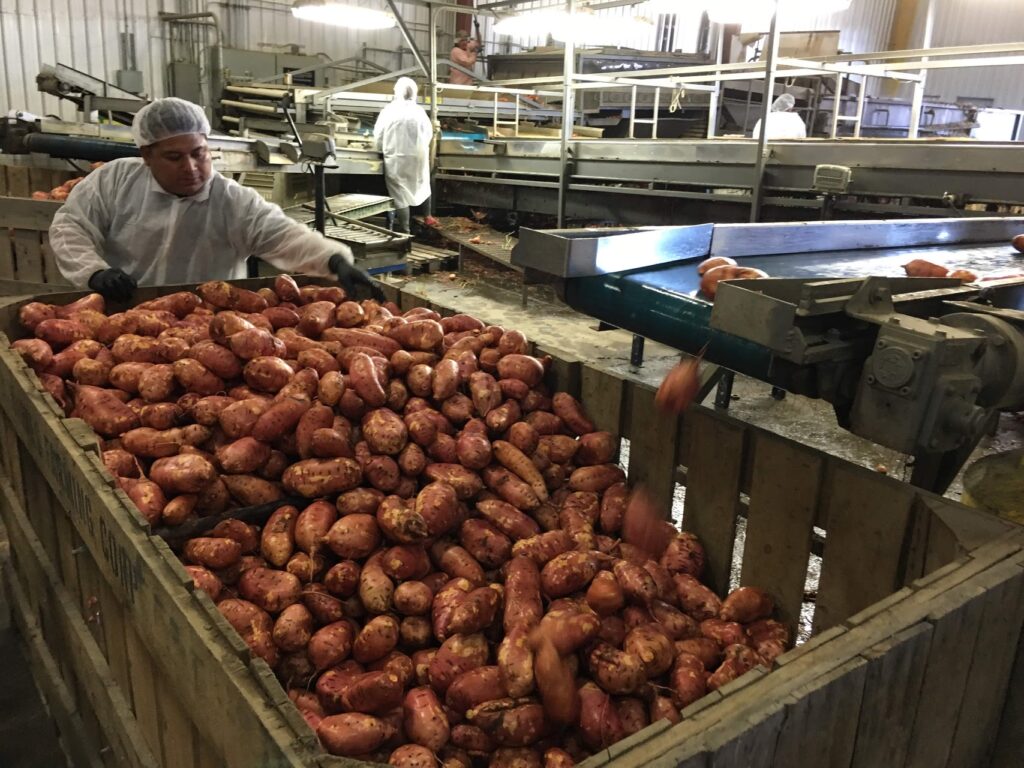Postharvest Curing, Storage, and Packing/Shipping
Postharvest curing and storage of sweetpotato storage roots are two critical steps in the sweetpotato production process that ensures the quality and longevity of the product on its journey to consumers. When executed properly, curing and storage can ensure the stability of sweetpotato storage roots for many months postharvest, allowing for the year-round sale of sweetpotatoes.
Curing Process
Curing requires the maintenance of high temperatures (80 to 85 degrees Fahrenheit) and high relative humidity (90 percent) over a period of approximately 6 to 8 days (Kemble et al., 2022). The curing time can be adjusted depending on the specific sweetpotato cultivar, given that some cultivars may be more prone to sprouting. In addition to stable temperatures and relative humidity, it is incredibly important that there is proper ventilation. The curing process improves the visual appeal, shelf life, and flavor of the sweetpotato storage roots as well as serves to aid in the healing process if roots were damaged during harvest. Although curing may be an important step in the production process for longevity and quality of the sweetpotato storage roots, growers, packers, and shippers can opt-out of the curing process and proceed with the packaging and sale of “green” roots. Given that lack of curing, these green roots will not possess the same storage ability and are not marketable year-round given this lack of longevity. Thus, green roots are often packed and shipped soon after harvest to ensure delivery to consumers within their short timeframe of longevity. Further, given the lack of curing, the sweetpotato storage roots will not have the same qualities, particularly when it comes to their flavor profile.
Fun Fact: Traditional curing is rarely practiced in California due to the cost and time constraints involved. Rather, growers often opt for the sweetpotato storage roots to cure underground!
Storage Process
The storage process is critical to maintaining root quality post-curing and ensuring the stability of sweetpotato storage roots for sale throughout the year. Proper storage includes the maintenance of low temperatures (approximately 55 degrees Fahrenheit) and high relative humidity (85 percent) with the addition of adequate ventilation (Kemble et al., 2022). Temperatures should not fall below 55 degrees Fahrenheit, especially for extended periods of time, to prevent chilling injury (Kemble et al., 2022). Further, temperatures should not rise above 60 degrees Fahrenheit to prevent sprouting and loss of root weight (Kemble et al., 2022). With the maintenance of proper storage conditions, sweetpotato storage roots can remain marketable for up to 13 months (Edmunds et al., 2008).
Packing and Shipping Process
Following the curing and storage process, sweetpotato storage roots are ready for packing and shipping. When the process of packing begins, sweetpotatoes are taken out of storage, washed, and graded by size. In addition to these steps, fungicides or other decay control treatments may be applied (see table below). The application of fungicides is commonly associated with sweetpotato roots that are not destined for canning and helps to prevent the establishment of decay-producing organisms that may enter through wounds produced through the washing or grading process (Edmunds et al., 2008). After these steps, sweetpotato storage roots can be packed up into boxes for shipping.

Credit: Daniel Tregeagle
Table 1. The table below has been adapted from the NC State Extension Postharvest Handling of Sweetpotatoes Publication and the LSU AgCenter Sanitation in the Sweet Potato Packinghouse Factsheet.
| Decay Control Product (Sanitizing Agents) | Application Method | Rate | Comments |
|---|---|---|---|
| Dicloran (Botran) | Spray Curtain Dip In Wax | See label. | See label. |
| Chlorine (Liquid chlorine, chlorine gas, and sodium hypochlorite) | - | See label. | The concentration of free (not total) chlorine should be monitored periodically and kept within the range of 100 to 150 parts per million. The optimal pH for the most efficient sanitizing is within the range of 6.5 to 7.5. |
| Chlorine dioxide | - | See label. | See label. |
| Hydrogen dioxide | - | See label. | See label. |
| Peroxyacetic acid (peracetic acid, bacteria-based biological control) | Spray Curtain Dip In Wax | See label. | Concentrated peroxyacetic acid is highly toxic and must be handled with care, however. The efficiency of peroxyacetic acid as a sanitizer also is affected by pH, and it is much more effective at a pH of 7 or less. |
Learn more about sanitation in the sweetpotato packinghouse.